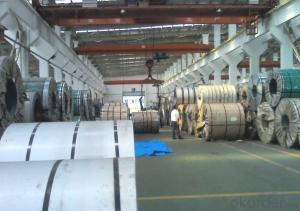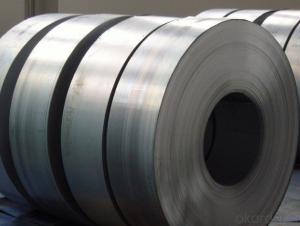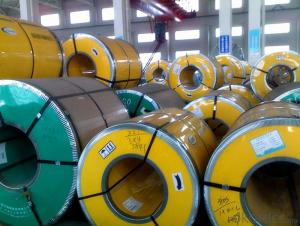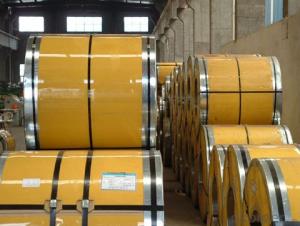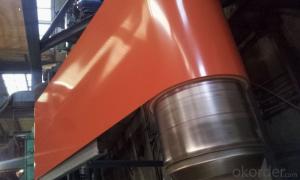Steel Coil/Hot Dip Galvanized Steel Strips Coil
- Loading Port:
- Tianjin
- Payment Terms:
- TT OR LC
- Min Order Qty:
- 1000 m.t.
- Supply Capability:
- 100000 m.t./month
OKorder Service Pledge
OKorder Financial Service
You Might Also Like
Steel Coil/Hot Dip Galvanized Steel Strips Coil Description:
Galvanized steel coil are widely used in the construction industry, as raw material for the production of corrugated panels, fencing products, drywall panel profiles, ventilation systems etc. Recommended for both outside and inside usage, galvanized steel has a high resistance to corrosion in different environments, due to a protective layer of zinc of 100 – 180 grams per square metre.
Main Feature of Steel Coil/Hot Dip Galvanized Steel Strips Coil:
Hot-dip galvanized steel coils are produced by immersing steel in a zinc bath. An appropriate galvanizing process requires a pretreatment process during which the steel passes through different baths which prepare the surface for zinc coating. In this stage, chemicals are used to clean the surface of the steel. After the chemical treatment, the steel coils pass through a bath of melted zinc at temperatures around 460 ° C. The resulting uniform coating is finished through a process of skin-passing to provide smooth and shiny appearance of the finished product. To store for a longer period, the hot-dip galvanized coils can be delivered with a final oil coating, according to the customer’s demand.
Steel Coil/Hot Dip Galvanized Steel Strips Coil Specification:
Steel strips coils galvanized
Material: Q195, Q215, Q235, Q345B, SGCC, DX51D+Z
Thickness:0.75-4.5mm
Width:32-750mm
Zinc coating: 60-550g/m2
Steel Coil/Hot Dip Galvanized Steel Strips Coil Images:

FAQ:
Q: Are you manufacturer of trading company?
A: Yes.
- Q:What is the meaning of C hot strip material, B material is how to distinguish between
- Hot rolled steel plate surface is plated black brown, plating cold rolled plate surface is gray, after plating from the surface smoothness to distinguish, lengzha board smoothness is higher than that of hot rolled steel plate.
- Q:What are the factors affecting the price of steel strips?
- Several factors can affect the price of steel strips. These include the cost of raw materials such as iron ore and coal, fluctuations in energy prices, supply and demand dynamics in the steel industry, changes in government policies and regulations, currency exchange rates, competition among steel manufacturers, and global economic conditions. Additionally, advancements in technology and production processes, as well as environmental considerations, can also impact the price of steel strips.
- Q:What are the different sizes and dimensions of steel strips?
- The sizes and dimensions of steel strips can vary depending on the specific application and industry requirements. However, common sizes range from thin strips measuring around 0.1mm to thicker strips up to 20mm in thickness. The width of steel strips can range anywhere from a few millimeters to several hundred millimeters, while the length can vary from a few meters to coils of several kilometers. It's important to note that these dimensions can be further customized based on the needs of the customer and the intended use of the steel strips.
- Q:How are steel strips used in the production of solar mounting systems?
- Steel strips are an integral component in the production of solar mounting systems due to their strength, durability, and versatility. These strips are often used for various purposes throughout the manufacturing process. Firstly, steel strips are commonly employed in the fabrication of the structural frames of solar mounting systems. These frames serve as the foundation for solar panels, providing stability and support. Steel strips are shaped and formed into the desired frame structure, ensuring it can withstand the weight of the solar panels and withstand environmental conditions such as wind and snow loads. Moreover, steel strips are also utilized in the creation of mounting brackets and rails. These components are responsible for securely fastening the solar panels onto the mounting system. Steel strips are cut and shaped into the required dimensions to form these brackets and rails, ensuring a precise fit and a secure attachment for the solar panels. Furthermore, steel strips are often galvanized or coated with protective layers to enhance their resistance to corrosion and extend their lifespan. This is crucial for solar mounting systems as they are typically exposed to various weather conditions, including rain, humidity, and temperature fluctuations. The protective coating on steel strips ensures that the mounting system can withstand these elements, providing long-lasting support for the solar panels. In summary, steel strips play a vital role in the production of solar mounting systems. They are used to fabricate the structural frames, mounting brackets, and rails, providing strength, durability, and stability to the entire system. With their versatility and resistance to corrosion, steel strips ensure the longevity and reliability of solar mounting systems in harnessing renewable energy from the sun.
- Q:Are steel strips suitable for the production of hand tools?
- Yes, steel strips are suitable for the production of hand tools. Due to their high strength, durability, and resistance to wear and tear, steel strips are commonly used in the manufacturing of various hand tools. The material provides the necessary rigidity and structural integrity required for hand tools to withstand heavy usage and perform effectively. Additionally, steel strips can be easily shaped, heat-treated, and tempered to enhance their hardness and functionality, making them an ideal choice for hand tool production.
- Q:How are steel strips used in the railway sector?
- Steel strips are used in the railway sector for a variety of purposes, including the manufacturing of rails, tracks, and various components of the railway infrastructure. They provide strength, durability, and stability to ensure the safe and efficient movement of trains.
- Q:How do steel strips perform under high temperatures?
- Steel strips are generally highly effective when subjected to high temperatures. Steel is renowned for its high melting point, which can vary from 1370°C to 1520°C (2500°F to 2750°F), depending on the specific type of steel. Consequently, steel strips possess the ability to endure exceedingly high temperatures without melting or compromising their structural integrity. Moreover, steel strips exhibit commendable thermal stability when exposed to elevated temperatures. They possess a low coefficient of thermal expansion, resulting in minimal expansion and contraction in comparison to other materials. This characteristic serves to prevent the warping or deformation of the strips when confronted with high temperatures. Additionally, steel strips possess exceptional strength and hardness, even under elevated temperatures. Although the strength of steel diminishes slightly as temperatures rise, it remains significantly stronger than numerous other materials. This attribute renders steel strips suitable for applications where resistance to high temperatures and mechanical strength are vital, such as in furnaces, boilers, and heat exchangers. Nevertheless, it is crucial to acknowledge that prolonged exposure to extremely high temperatures can bring about alterations in the properties of steel strips. At exceedingly high temperatures, steel may experience oxidation or scaling, leading to a deterioration in surface quality or corrosion resistance. Furthermore, repeated cycles of heating and cooling can result in thermal fatigue, causing the steel to become more brittle over time. As a result, careful consideration of these factors is necessary, along with the selection of the appropriate steel grade and surface treatment, to ensure optimal performance in high temperature conditions.
- Q:Can steel strips be used in the transportation industry?
- Steel strips have a wide range of applications in the transportation industry. Their versatility and durability make them suitable for various purposes. In the manufacturing process, they can be utilized to create different components, including brackets, supports, and reinforcements for vehicles such as cars, trucks, trains, and ships. Due to their high strength and resistance to impact and deformation, steel strips are commonly used in the construction of chassis, frames, and body panels. They also play a crucial role in the production of springs, suspension systems, and exhaust systems, which are essential for ensuring the smooth and safe operation of vehicles. Overall, the transport industry relies heavily on steel strips, appreciating their reliability, strength, and versatility.
- Q:How are steel strips used in the production of metal packaging?
- Metal packaging relies on steel strips for various purposes. One common application involves the production of metal cans, particularly those used for food and beverages. Initially, steel strips are rolled into thin sheets and then cut into specific sizes and shapes to form the can's body. These strips provide the necessary strength to withstand the pressure and weight of the contents. Moreover, steel strips find utility in the creation of metal lids and closures for cans. These strips are molded into the desired lid design and subsequently affixed to the can body. By utilizing steel strips, the lids can be securely sealed, preventing any potential leakage or contamination of the packaged goods. Furthermore, steel strips play a pivotal role in manufacturing metal drums and barrels. These containers are frequently employed to store and transport various liquids, chemicals, and hazardous materials. The steel strips are rolled and welded together, forming a robust cylindrical structure capable of enduring the weight and pressure exerted by the contents. Additionally, the strips contribute to maintaining the necessary rigidity and strength, thereby preventing any deformation or damage to the drum during handling and transportation. In conclusion, steel strips are indispensable components in the production of metal packaging. They are instrumental in constructing the body of cans, lids, and closures, as well as the structure of drums and barrels. The versatility and strength of steel make it an ideal material for ensuring the integrity and safety of the packaged goods.
- Q:Can steel strips be used for making kitchen appliances?
- Yes, steel strips can be used for making kitchen appliances. Steel is a durable and versatile material that is commonly used in the manufacturing of various kitchen appliances, such as refrigerators, ovens, dishwashers, and cooktops. Steel strips are often used in the construction of the outer casings or body of these appliances due to their strength, resistance to heat and corrosion, and aesthetic appeal. Additionally, steel strips can also be used for making smaller kitchen appliances like blenders, toasters, and coffee makers, where their durability and sleek appearance are valued. Overall, steel strips are a popular choice for making kitchen appliances due to their reliability, longevity, and ability to withstand the demands of everyday use in a kitchen environment.
1. Manufacturer Overview |
|
|---|---|
| Location | |
| Year Established | |
| Annual Output Value | |
| Main Markets | |
| Company Certifications | |
2. Manufacturer Certificates |
|
|---|---|
| a) Certification Name | |
| Range | |
| Reference | |
| Validity Period | |
3. Manufacturer Capability |
|
|---|---|
| a)Trade Capacity | |
| Nearest Port | |
| Export Percentage | |
| No.of Employees in Trade Department | |
| Language Spoken: | |
| b)Factory Information | |
| Factory Size: | |
| No. of Production Lines | |
| Contract Manufacturing | |
| Product Price Range | |
Send your message to us
Steel Coil/Hot Dip Galvanized Steel Strips Coil
- Loading Port:
- Tianjin
- Payment Terms:
- TT OR LC
- Min Order Qty:
- 1000 m.t.
- Supply Capability:
- 100000 m.t./month
OKorder Service Pledge
OKorder Financial Service
Similar products
New products
Hot products
Related keywords




















